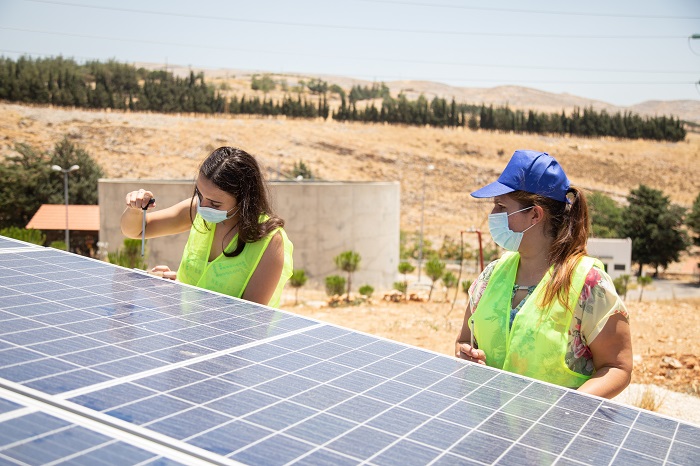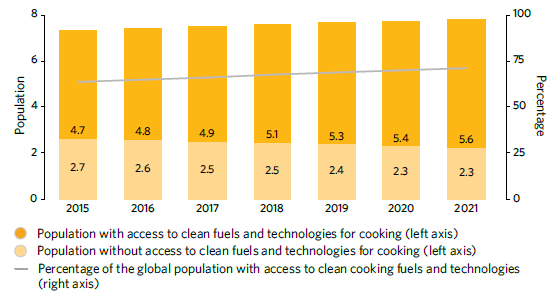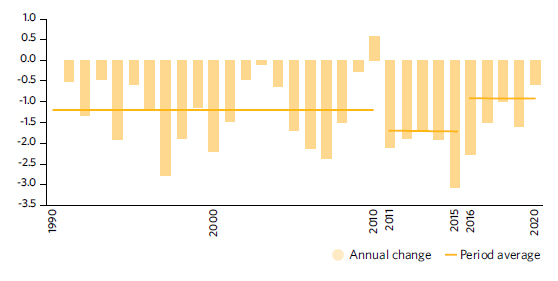Affordable and clean energy

In Lebanon, women install solar panels as part of efforts to empower women in the renewable energy sector, improving their skills for economic empowerment during crises and the pandemic
© UNDP Lebanon/Rana Sweidanimprove energy efficiency and develop enabling policies and regulatory frameworks.
More people than ever have access to electricity, but the pace is lagging for least developed countries
The global electricity access rate increased from 87 per cent in 2015 to 91 per cent in 2021, serving close to an additional 800 million people. However, 675 million people still lacked access to electricity in 2021, mostly located in LDCs. Despite steady progress in the last six years, the annual access growth rate of 0.6 percentage points between 2019 and 2021 lags behind the 0.8 percentage points observed in 2015–2019. In sub-Saharan Africa, due to population growth, the number of people without access has remained stubbornly stagnant since 2010, leaving 567 million without access in 2021. Electrification can help increase educational attainment, improve health care, support agriculture development, reduce gender inequality, enhance climate action and create business opportunities and jobs. However, if the current pace continues, some 660 million people will still be without electricity by 2030. To change course and achieve universal access by 2030, the access rate must increase by 1 percentage point annually between 2021 and 2030.
Proportion of population with access to electricity, 2015 and 2021 (percentage)

*Excluding Australia and New Zealand.
At the current pace, a quarter of the population will still be using unsafe and inefficient cooking systems by 2030
In 2021, around 2.3 billion people – 29 per cent of the global population – were still relying on inefficient and polluting cooking systems, jeopardizing their health, limiting their life opportunities, and damaging the climate and environment. Between 2015 and 2021, the proportion of people with access to clean cooking fuels and technologies increased only by 7 percentage points. However, South-Eastern Asia saw significant and consistent progress, achieving access for around three-quarters of its population in 2021, up 14 percentage points from 2015. Conversely, the region with the lowest access rates was sub-Saharan Africa, where progress towards clean cooking has failed to keep pace with growing populations, leaving a total of 0.9 billion people without access in 2021. If current trends continue, only 77 per cent of the global population will have access to clean cooking solutions by 2030, leaving nearly 1.9 billion people behind, including 1.1 billion in sub-Saharan Africa.
Absolute number of people and proportion of the global population with access to clean cooking fuels and technologies, 2015–2021 (billions and percentage)

Renewable energy use is growing in the electricity sector, but limited in heating and transport
Globally, in 2020, renewable sources accounted for 19.1 per cent of total final energy consumption, representing a 2.4-percentage-point increase from 2015. Over the same period, total renewable energy consumption increased by 16 per cent. Traditional uses of biomass – such as the burning of wood in open stoves or fireplaces – still represented over a third of total renewable energy use in 2020. But modern renewable sources are slowly expanding, from 10 per cent of total final energy consumption in 2015 to 12.5 per cent in 2020. The electricity sector shows the largest share of renewables in total final energy consumption (28.2 per cent in 2020). However, progress in the heating and transport sectors has been limited over the past decade, as upward trends in demand have outpaced the deployment of renewables. Meeting the targets of Goal 7 and the Paris Agreement will require sustained policy momentum to scale up both renewable energy deployment and energy conservation in all sectors, as well as to mobilize public and private investment, particularly in developing countries.
Share of renewable sources in final energy consumption and by end use, 2015 and 2020 (percentage)

A strong rebound is needed to reach energy efficiency targets
Global primary energy intensity, defined as the ratio of total energy supply to GDP – in essence, the amount of energy used per unit of wealth created – improved from 4.96 megajoules per dollar (2017 purchasing power parity) in 2015 to 4.63 in 2020, representing an average annual improvement rate of 1.4 per cent. This is well below the 2.6 per cent required to meet target 7.3 of doubling the global rate of improvement in energy efficiency by 2030 (compared with the baseline rate of 1990–2010). In 2020, the improvement rate slowed down to 0.6 per cent, due to the COVID-19 crisis, marking the smallest gains since the global financial crisis. It is expected that energy intensity will improve at a higher pace in 2022. However, to make up for lost time, energy intensity improvements will need to average 3.4 per cent per year until 2030. Prioritizing energy efficiency in policy and increasing investment can help the world achieve energy and climate targets.
Annual change of global primary energy intensity, 1990–2020 (percentage)

International public financing for clean energy in developing countries continues to decline
International public financial flows in support of clean energy in developing countries have been on a decreasing trend, starting even before the COVID-19 pandemic and continuing through 2021. They amounted to $10.8 billion in 2021, down by nearly 12 per cent from 2020. This was 35 per cent less than the 2010–2019 decade-long average, and less than half the 2017 peak of $26.4 billion. In 2021, the distribution of financial flows by technology shifted from hydropower to solar energy: with solar accounting for 43 per cent; other renewables garnering 33 per cent of flows; and the lowest number of commitments being for hydropower (16 per cent), and wind and geothermal energy (8 per cent combined). These decreasing trends jeopardize the chances of achieving energy goals, particularly for LDCs, landlocked developing countries (LLDCs) and small island developing States (SIDS).
Renewable energy is booming in developing countries, but the least developed are falling behind
In 2021, developing countries installed a record-breaking 268 watts per capita of renewable energy-generating capacity, following two decades of steady increases that have consistently outpaced population growth. The compound annual growth rate of renewable energy in developing countries from 2016–2021 was 9.6 per cent, compared to 8.6 per cent for 2010–2015. But despite this positive and accelerating growth, developing countries are still not on track to meet SDG 7.b targets by 2030, and those countries most in need are being left behind. From 2016 to 2021, the annual growth rate was significantly lower for SIDS (8.5 per cent), LDCs (5.5 per cent) and LLDCs (3.8 per cent). At current rates, LDCs would need almost 40 years, LLDCs 25 and SIDS 13 years to reach the same level of deployment that developing countries overall achieved in 2021. Closing these gaps will require tailored policies and investments to ensure a just and climate-safe energy transition.

